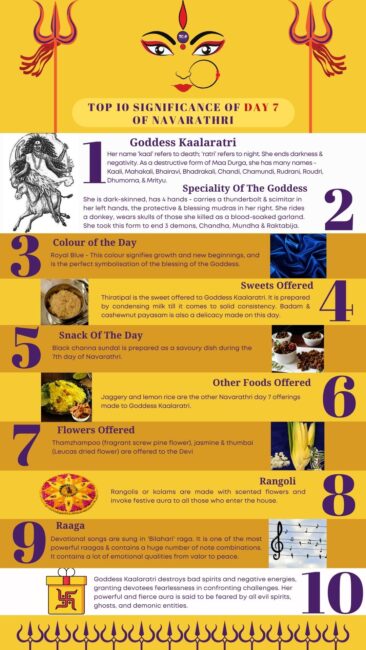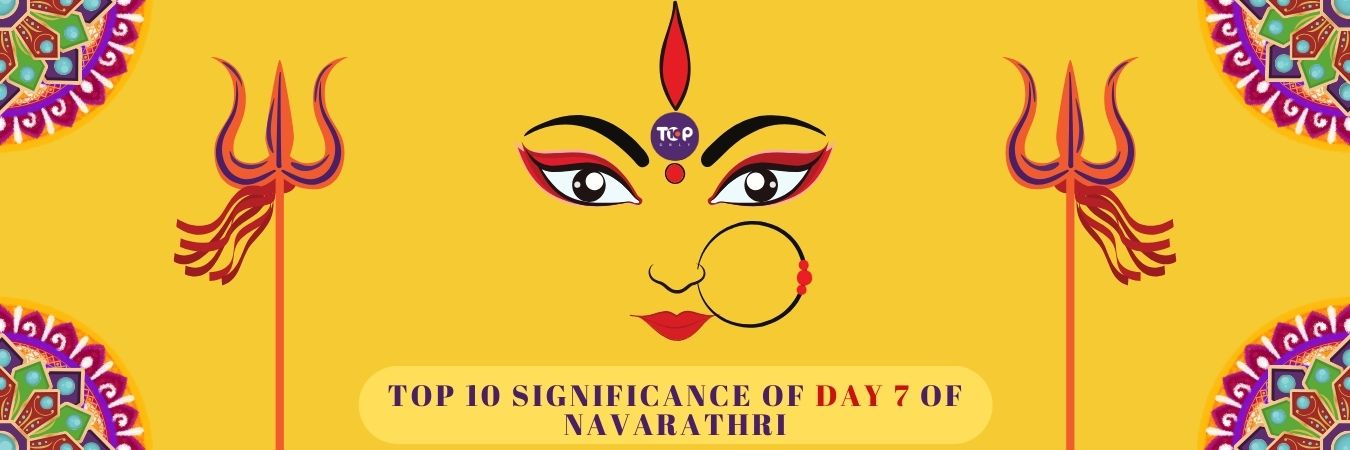Updated on: 16.09.2024

The auspicious day 7 of Navarathri is celebrated in honour of Goddess Kaalaratri. She is known to be feared by all evil spirits. She removes darkness and negativity from her devotee’s life. Like other forms of Durga, this form also emits divinity and feminine power. Let us dive deep into the top 10 significance of day 7 of Navarathri.
Top 10s Only presents a brief glimpse of the traditions associated with Day 7 of the Navarathri festival that will be celebrated on October 9, 2024 (Wednesday).
Did you miss our post about the top 10 significance of Day 6 of the Navarathri festival? In case you did, you can read about it here on our site!
Significances Of Day 7 Of Navarathri
The 7th day of Navarathri is celebrated to mark the victory of Devi Kaalaratri on three demons Chandha, Mundha, and Raktabija.
1. The Name Of Goddess Worshipped On Day 7 Of Navarathri
Navarathri day 7 is dedicated to the worship of Goddess Kaalaratri. Her name ‘kaal’ refers to death and ‘ratri’ refers to the night. As her name suggests she is known to end darkness and negativity. She is one of the destructive forms of Maa Durga and is called by many names like Kaali, Mahakali, Bhairavi, Bhadrakali, Chandi, Chamundi, Rudrani, Roudri, Dhumorna, and Mrityu.
2. The Speciality Of The Goddess Worshipped On Day 7 Of Navarathri
Goddess Kaalaratri is among the fiercest forms of Goddess Durga. She appears with a dark complexion and has four hands. She is seen carrying a thunderbolt and scimitar in her left two hands while her right hands hold the protection and blessing mudras. She rides a donkey, wears skulls of those she killed as a blood-soaked garland.
The legend has it that she was formed to end three demons namely Chandha, Mundha and Raktabija. Goddess Chandi is the one who created Goddess Kaalaratri as another powerful form of herself because she was unable to kill the demons in her form. Though Chandha and Mundha were killed, Raktabija had a special boon that for every drop of blood that fell on the ground another lookalike would be created. Maa Kaalaratri fiercely fought against them and won in the end.
In this form, Goddess Parvati lets go of her fair skin that is serene and calm and adopts a black form of a raging deity. Her abode is the crown chakra.
3. The Colour On Day 7 Of Navarathri
The Navarathri Day 4 colour is Royal Blue. This colour signifies growth and new beginnings, and is the perfect symbol of the blessing of the Goddess.
4. The Sweets To Be Offered On Day 7 Of Navarathri
Navarathri day 7 bhog is Thirattupal, which is prepared by condensing milk till it comes to solid consistency. ‘Thirattu’ means continuous stirring to concentrate the ingredients and ‘pal’ means milk. The slight sweetness of milk in the condensed state is what makes this sweet a yummy treat for many. Badam and cashewnut payasam is also a delicacy made on this day.
5. The Snacks To Be Offered On Day 7 Of Navarathri
Along with the sweet, black channa sundal is prepared as a savoury dish during the 7th day of Navarathri.
6. The Other Food Items To Be Offered On Day 7 Of Navarathri
Jaggery and lemon rice are the other Navarathri day 7 offerings made to Goddess Kaalaratri. A garland made of lemons is hand-made and placed around her neck.
7. The Flowers To Be Offered On Day 7 Of Navarathri
Thamzhampoo (fragrant screw pine flower), jasmine and thumbai (Leucas dried flower / Leucas Aspera) are the flowers used on this day during rituals and offerings.
8. The Rangoli On Day 7 Of Navarathri
Rangolis or kolams are made with scented flowers and invoke festive aura to all those who enter the house.
9. The Raaga On Day 7 of Navarathri
Devotional songs are sung in Bilahari raga. It is one of the most powerful raagas and contains a huge number of note combinations. It contains a lot of emotional qualities from valor to peace.
10. The Belief On Day 7 Of Navarathri
Goddess Maa Kaalaratri is believed to be the destroyer of all bad spirits and negative energies. She is believed to bring peace by eradicating all evils. It is believed that devotees worshipping her are blessed with a fearlessness to face challenges. Her powerful and fierce aura is said to be feared by all evil spirits, ghosts, and demonic entities. This day is celebrated with great valour and happiness to mark Goddess Kaalaratri’s victory over demons.
Hope you enjoyed reading the significance of day 7 of Navaratri. Do let us know what different rituals you follow, other than those mentioned here, in the comments.
If you are still interested in reading more about the festival of Navarathri, you may find reading about the Top 10 Significance Of Day 8 Of Navarathri very interesting.


Pingback:Navarathri Day 8 Significance - Maa Mahagauri | Top 10s Only